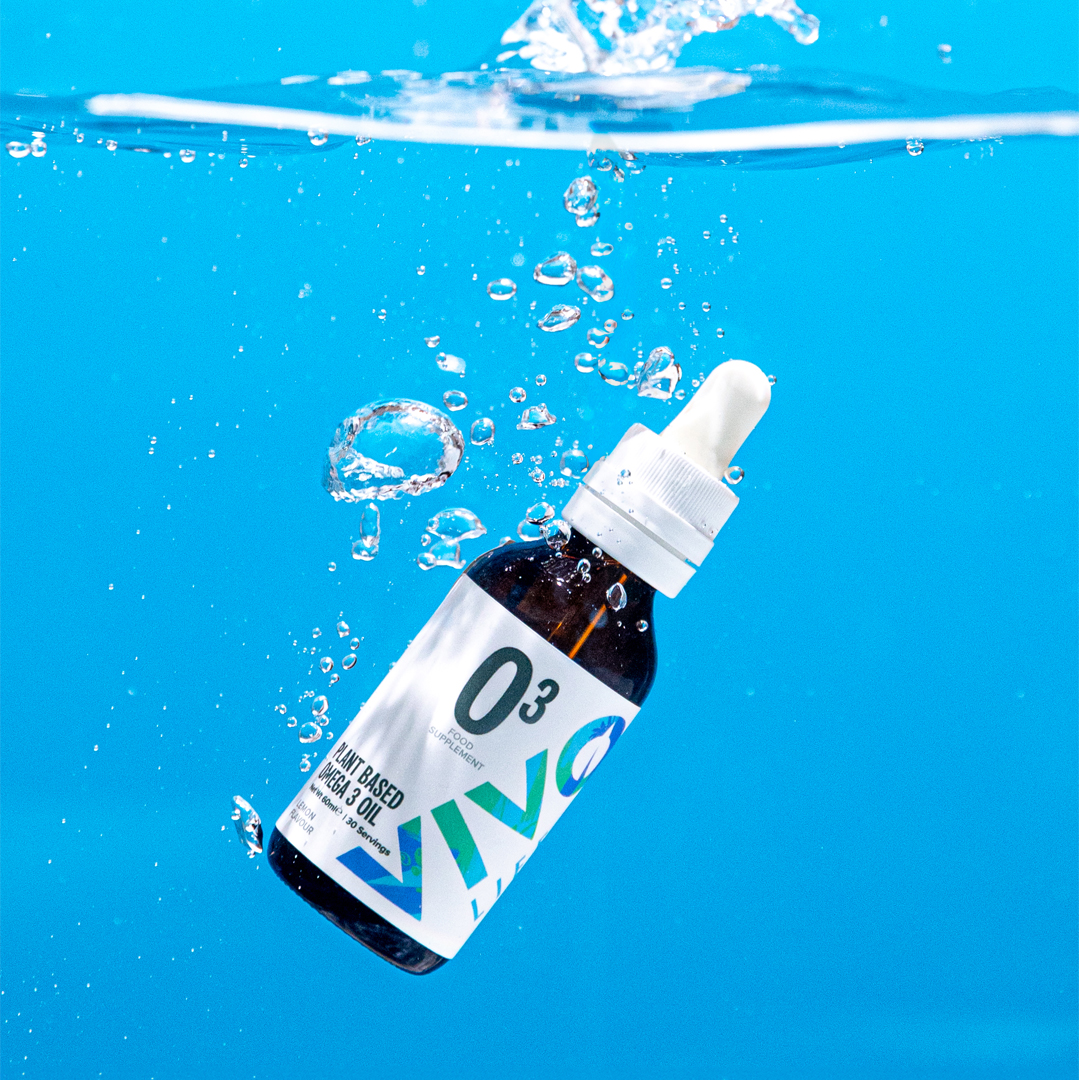PLANT BASED OMEGA 3 LIQUID
Updated
by Kat Hoyle
What is Omega 3?
Omega 3 fatty acids are types of polyunsaturated fats (double bonded), they are essential nutrients found in 3 forms: EPA (eicosapentaenoic acid), DHA (docosahaxaenoic acid) and ALA (alpha-linolenic acid). They are named “essential” as the body cannot create them itself, and therefore we must obtain omega 3s from our diet. EPA and DHA are usually found in fish, animal products, phytoplankton, and algae plant life. ALA is found in animal products and plant sources such as flax and hemp seeds.

The common source for omega 3 via supplements has been fish oil capsules, but more recent nutritional research has uncovered algae to be a comparable and reliable source for EPA and DHA omega3. The reason for this being that fish themselves do not synthesize omega 3, they in fact consume it by eating smaller fish, phytoplankton (who eat algae) and some fish also eat algae directly.
With a plant-based diet lacking in sources of EPA and DHA, supplementation in the form of algae-based omegas is advisable.
The following information should not be substituted for medical advice. In the case of medical conditions, please consult with your doctor or nutritionist for information on dosage and suitability for your personal needs.
Our Omega 3
Nutritional information | Typical values per serving (2ml) * |
Total Omega 3 Fatty Acids | 1000mg |
EPA (Eicosapentaenoic Acid) | 300mg |
DHA (Docosahexaenoic Acid) | 600mg |
* Due to natural origin of the product the values can vary + - 15%
Why do we need Omega 3?
Healthy fats are essential for optimal health. Omega 3 plays an important role in regulating various biological systems and processes such as the bodies inflammatory response, various metabolic pathways, cardiac health, brain function, hormone production, mineral absorption, and providing structural integrity for our cells.
The different types of omega-3 have different roles in the body. For instance, ALA is involved in cardio vascular health and DHA is involved in brain health and cognitive performance.
Can it be obtained from a plant-based diet?
Omega 3’s in the form of ALA (alpha-linolenic acid) can be found in some plant sources such as flax and hemp seeds, spinach, soy-beans and even walnuts. For the body to use ALA it must convert the fatty acid into EPA and DHA itself. Unfortunately, the conversion rates are extremely inefficient, different sources quote varying rates of conversion, but the consensus is that we cannot rely on this conversion of ALA to meet our bodies omega 3 requirements. This already unsustainable rate of conversion is also made worse in the presence of omega 6 fatty acids, which are commonly found in modern diets. It can be concluded that the beneficial effects of plant-based omega 3 in the form of ALA are extremely limited. Fortunately for those that do not consume fish, algae-based omega 3 is a wonderful and arguably more sustainable alternative.
Omega 3’s relationship with Omega 6
It is important to balance our dietary intake of omega 6’s and omega 3’s. Omega 6’s (another polyunsaturated fat) get a bad name, but they are in fact also essential to supporting cellular functioning. The problem may arise when omega 6 is over consumed, and when omega 6 and omega 3 is out of balance. Omega 6 is found in many plant sources like walnuts, sunflower seeds, and plant oils, and generally most people are getting enough from their diets. It is unlikely that one would ever need to supplement significant amounts of omega 6 (only in unusual cases and directed by a nutritionist/doctor).
An individual’s intake/balance of omega 6 and omega 3 is thought to regulate vascular activity and immune and nervous system function. The optimal dietary ratio of omega 6 to omega 3 is believed to be approximately 4:1. Modern Western diets tend to shift that ratio out of balance, sitting around 15:1. Over consumption of omega 6, or an unbalanced omega 6 – omega 3 ratio is thought to contribute to cardio-vascular conditions, and excessive inflammation in the body.
If one is following a whole-foods plant-based diet, without high consumption of refined plant oils such as soy-bean oil or canola oil, then ensuring you are getting enough omega 3 should be enough to balance out the ratio. Consuming a lot of refined plant oils and other less desirable omega 6 sources is not recommended and reducing intake of such foods as well as ensuring enough dietary omega 3 is consumed should restore the balance.
There is a small amount of omega 6 in our product, to help encourage this natural balance. There is 96 mcg of omega 6 per 2ml serving of our omega 3 liquid, as well as 148 mcg of omega 9. When consumed along side a whole foods plant based diet this amount is not enough to be of concern regarding over consumption of omega 6.

Omega 3 and Inflammation
EPA and DHA omega 3’s are important in supporting the body’s natural inflammatory response, the first action of the body in response to damage to tissue or infection. Inflammation is the immune systems response to harmful stimuli, such as injury, pathogens, damaged cells, or toxins etc. This process is essential to human health and a balance of cellular and molecular events occur to mediate this response. In some cases, these cellular and molecular processes are not mediated, and inflammation may become chronic and out of control causing long term oxidative stress. Here we have the risk of inflammatory conditions arising, such as arthritis, IBS, Crohn’s disease or Parkinson’s disease. There are in fact hundreds of conditions that are considered inflammatory diseases, some more severe than others, but it is evident that unchecked inflammation plays a role in almost all disease.
EPA and DHA provide potent signaling molecules that mediate the inflammatory response, helping to prevent inflammation becoming chronic and keeping everything balanced. Resolvins are derived from EPA and DHA, that are aptly named for their capacity to “resolve” inflammation. Alongside resolvins, DHA derived molecules named protectins are believed to be the cause of Omega 3’s neuroprotective benefits. Over consumption of omega 6 is also thought to be pro-inflammatory. Consuming adequate omega 3 helps to balance the ratio of omega 6 and omega 3.
Omega 3 and Metabolism
Omega 3 has been shown to increase metabolism in some human studies. Our metabolism is a complex set of life-sustaining processes that include the conversion of energy from food into cellular energy, the conversion of food into amino acids, and the removal of metabolic wastes from the body. All these processes require energy and an increase in metabolism can lead to an overall daily calorific (energy) expenditure increase. EPA and DHA from omega 3 incorporates into cell membranes which is thought to increase cellular metabolism and alter gene expression. One study found that in healthy older women an intervention of 3g omega 3 per day for 12 weeks increased their metabolism by a staggering 14%. Other studies have found similar results with increases in metabolism from 3.8% to 5.3%. These findings that suggest that omega 3 supplementation could contribute to supporting metabolic health and even weight-loss in the appropriate circumstances.
Omega 3 and Cardiac Health
Omega 3 has long been associated with cardiac health.
A 2017 meta-analysis (a summary of the most current and reliable research of that time, considered the gold standard of research) concluded that EPA and DHA supplementation has the potential to lower coronary heart disease risk factors, DHA in particular has been shown to contribute towards healthy blood pressure.
Omega 3 and Brain Health
DHA in particular is integral for brain health and cognitive functioning. Our brain is made up of around 60% fat, and over half of that is DHA which illustrates the importance of this compound for our cognitive health. DHA is also the predominant structural component of our nervous system and the retina of our eyes.
DHA supplementation in children is thought to help prevent conditions such as ADHD, and the children of mothers who supplemented with attention deficit hyperactivity disorder (ADHD) were observed to have better eye-hand coordination, higher mental processing scores and improved psychomotor development. DHA supplementation is associated with enhanced learning capacity and academic performance.
DHA is also necessary for healthy brain function in adults, deficiencies are associated cognitive decline and even with early onset Alzheimer’s disease. Omega 3 has been shown to improve anxiety and a 2018 meta-analysis saw that evidence concurred in reducing the severity of depression symptoms.
Omega 3 in summary
We can see that omega 3 has far reaching health benefits and is an essential nutrient that has been a crucial nutrient in the health and development of humans over millennia. Sourcing from an algae source opposed to fish can provide the exact same benefits, with a far more sustainable approach.
Certificate of Analysis
Here at VIVO we third party test all our products for accuracy and purity.
Frequently Asked Questions.
- Does your algae come from tanks in contact with pollution from the sea?
Our algae is sustainably grown in controlled environments rather than sea water so it doesn't harbour heavy metals or pollutants found in the sea.
- Doesn’t our body do the conversion into DHA and EPA itself from ALA?
This is actually discussed further up in this article, scroll up or check out this blog post on Omega 3 which answers this exact question for you - we hope you enjoy the read and find it helpful! - Can I add my Omega 3 to hot food and drink?
We advise against heating your Omega 3 as heat will cause the fatty acids to break down. This will significantly lower the efficacy of the supplement, and reduce your overall intake of Omega 3.
- How many calories are in your Omega 3?
Our Omega 3 contains approximately 15-25 calories per serving.
- How should I store my Omega 3?
Your Omega 3 can be stored in a cool dark place until opened and then once opened it is important that you then store it in the fridge.
- Is the Omega 3 supplement suitable for children?
Our Omega 3 is a natural formula but the dosage is designed with adults in mind. Omega 3 is actively recommended at all ages and is especially important in the development of young children. We advise that you check this in either your own research or with the advice of a doctor or pediatric nutritionist as we cannot advice on dosage or indeed the suitability of our specific product for your child.
- My Omega 3 has turned cloudy?
This is completely normal. The omega 3 can become cloudy when kept in the fridge (as it should be) and this can also vary from batch to batch. The omega 3 molecules can crystallise at temperatures of 4 degrees and below so just leave it out of the fridge for 10 minutes or so before consuming which should help.
- In which environment do you produce the algae?
Our Omega 3 is taken from algae sustainably grown in controlled environments in the USA
- Why don't you use algae from the sea?
Unfortunately due to oceanic pollutants it is impossible to source algae from the sea and guarantee that it is 100% pollutant free. By growing in controlled environments we are able to ensure a clean, uncontaminated product.
- What is the maximum amount I can use each day?
There is currently no upper tolerable limit set, as the amount of omega 3 you need can vary depending on a number of factors. For healthy adults our recommended serving size is around 2ml per day, however we recommend consulting your GP for doses specific to your needs.
- What’s the mg per serving of EPA and DHA?
Each serving contains 600mg of DHA and 300mg EPA.
- When is the best time of day to take Omega 3?
Omega 3 can be taken any time of the day! If it makes it easier to remember, a good option is to take it in the morning with your breakfast or any other supplements you may use.
- Where is the lemon extract in your flavouring derived from?
Our lemon extract is derived from lemons.
- Why did we choose a liquid form over tablets?
We have chosen liquid form because it is much easier to provide a functional dose, and people can also tailor their dose to their specific needs. It also means no fillers, binders or thickeners are used (most capsules on the market are made with carrageenan which has been identified as a probable carcinogen).
- I already eat plant based foods containing Omega-3 – do I still need an Omega 3 supplement?
Seeds such as flax, hemp and chia seed contain a form of omega 3 called alpha-linolenic acid, or ALA for short. But in order for it to be used by our bodies ALA must first be converted into longer chain omega 3 fatty acids known as EPA and DHA. Unfortunately the conversion rates of ALA to EPA and DHA are not good, with an average 8% conversion to EPA and 0.5% to DHA. This means you would need to eat almost half a kilo of flaxseed daily just to get half a gram of DHA!

References
Alexis Ceecee Zhang, Sumeer Singh,Jennifer P. Craig,and Laura E. Downie. (2020). Omega-3 Fatty Acids and Eye Health: Opinions and Self-Reported Practice Behaviors of Optometrists in Australia and New Zealand. Nutrients. 12 (14), 1179.
A P Simopoulos. (2002). The importance of the ratio of omega-6/omega-3 essential fatty acids. Biomedicine & Pharmacoptherapy. 56 (8), 365-79.
EFSA Journal. (2010). Scientific Opinion on the substantiation of health claims related to docosahexaenoic acid (DHA). Available: https://efsa.onlinelibrary.wiley.com/doi/10.2903/j.efsa.2010.1734. Last accessed 11th April 2020.
Ella J Baker, Elizabeth A Miles, Graham C Burdge, Parveen Yaqoob, Philip C Calder. (2016). Metabolism and functional effects of plant-derived omega-3 fatty acids in humans. Progress in Lipid Research. 64 (1), 30-56.
J C Craddock, E P Neale, Y C Probst, G E Peoples. (207). Algal supplementation of vegetarian eating patterns improves plasma and serum docosahexaenoic acid concentrations and omega-3 indices: a systematic literature review. The Journal of Human Nutrition and Dietetic. 30 (6), 693-699.
K B Hadley, A S Ryan, E B Nelson, N Salem Jr. (2010). Preclinical safety evaluation in rats using a highly purified ethyl ester of algal-docosahexaenoic acid. Food and Chemical Toxicology. 48 (10), 2778-84.
L A Horrocks, Y K Yeo. (1999). Health benefits of docosahexaenoic acid (DHA). Pharmacological Research . 40 (3), 211-225.
Linlin Chen et al., . (2018). Inflammatory responses and inflammation-associated diseases in organs. Oncotarget. 9 (6), 7204-7218.
Meharban Singh. (2005). Essential fatty acids, DHA and human brain. Indian Journal of Pedeatrics. 73 (2), 239-242.
Nicolas G Bazan . (2005). Neuroprotectin D1 (NPD1): a DHA-derived mediator that protects brain and retina against cell injury-induced oxidative stress. Brain Pathology. 15 (2), 159-66.
Samantha L. Logan, Lawrence L. Spriet. (2015). Omega-3 Fatty Acid Supplementation for 12 Weeks Increases Resting and Exercise Metabolic Rate in Healthy Community-Dwelling Older Females. PLoS One. 10 (1), 10-13.
Sneh Punia et al.,. (2019). Omega 3-metabolism, absorption, bioavailability and health benefits–A review. PharmaNutrition. 10 (1), 100-162.
Yuhua Liao et al.,. (2019). Efficacy of omega-3 PUFAs in depression: A meta-analysis. Translational Psychiatry. 9 (190), 1-9.
